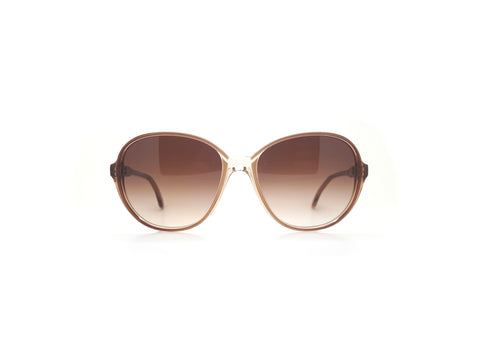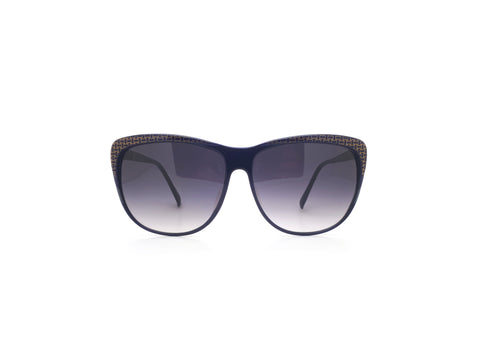
Blue light lenses are one of the hottest trends in eyewear with lots of new brands popping up in this fairly unregulated market. We have all seen the claims being made about blue light glasses - from better sleep to reducing headaches and eye strain but how much of this is actually true? In this blog post, we investigate the science behind blue light glasses and provide you with the key facts about blue light lenses and find out if these incredible claims are real and help you decide if you should get blue light lenses fitted to your next pair of vintage sunglasses or vintage glasses frames.
Is staring at a screen bad for me?
According to a recent poll by The Independent, the average person could spend 34 years of their life looking at screens. I have been staring at screens my whole life without actually giving it too much thought that it could actually be bad for my health. From my early years playing my Sega to the omnipresent smartphones and laptop I use to arrange my work and social life every day, there has not been a point in my life where I was not regularly using a screen each day.
I can recall my parents telling me to stop watching too much TV or my eyes would go square as a kid but was there any truth at all behind the claim? Well, we have some good news for you - the experts out there are saying that staring at a screen will not damage your eyesight. However, overly long screen time can lead to a feeling of eye fatigue and eye strain which is caused by focussing on one area for a long period of time.
According to the American Optometric Association, digital eye strain is "a group of eye and vision related problems that result from prolonged computer, tablet, e-reader and cell phone use." Issues range from blurry vision and dry eyes to headaches and neck pain.

What is Blue Light?
Blue light is not some new phenomenon of light that was recently discovered with the invention of LED TVs and smartphones. It is, in fact, all around us and is naturally occurring - blue light is just light travelling with shorter wavelengths and thus they carry more energy than some other colours of light. The reason we see the sky as blue is because of the sun emitting these blue light wavelengths and they are bounced and reflected on the earth's atmosphere.
Did you know that not all colours of light have the same effect? Blue wavelengths—which are beneficial during daylight hours because they boost attention, reaction times, and mood—seem to be the most disruptive at night. And the proliferation of electronics with screens, as well as energy-efficient lighting, is increasing our exposure to blue wavelengths, especially after sundown.
Wait so Blue Light is already all around me?
Yep, that's right you can't hide from the blue light wavelengths and it may actually be bad for you to do so. Sunlight is still the main source of blue light by a long way, even when you are sat in an office - unless you have no windows (in which case it's time to find a new office!)
There are a growing number of sources of artificial blue light such as your LED bulbs, TV and laptop screens and of course the smartphone in your pocket.
What effect does Blue Light have on me?
The short answer - Blue light actually boosts energy, attention and reaction times!
It might seem surprising to know that blue light actually has a whole load of positive effects on the body, especially if you have been spammed by adverts on Instagram telling you that you have been getting headaches from all that blue light you have been exposed to.
Blue light has been found to actually stimulate your noggin more than other colours of light. George Brainard, PhD, a professor of neurology at Thomas Jefferson University, found that when testing the reaction times of two groups - one control group with green light and another group with exposure to blue light - that the exposure to blue light led to fewer reports of tiredness and fatigue throughout the day!
The researchers subsequently found that participants exposed to blue light consistently rated themselves as less sleepy, had quicker reaction times, and experienced fewer attention lapses during performance tests as compared to those who were exposed to green light.

What does my smartphone or laptop have to do with this?
When compared to previous generations of lighting technology the LED bulbs behind your TVs and smartphones emit blue light in larger quantities. There have also been studies that have shown that an increased exposure to blue light can have an effect upon your circadian rhythms which help govern and determine your sleep patterns.
Some studies have shown that lots of exposure to blue light after sunset can lead to difficulties with falling into and maintaining sleep. Given that your 40 winks are vital to both your mental and physical wellbeing anything that wants to meddle with those precious ZZZs had better be worth it.
Is blue light harmful?
No, no and once again for people at the back NO. Blue light wavelengths are not harmful and the overwhelming evidence is that they are actually beneficial rather than damaging.
Why is there an entire field of eyewear devoted to removing blue light?
This is a harder question to answer than just the pure pursuit of profit. Over the past few decades there has been a marked rise in complaints of eye strain or Computer Vision Syndrome as it is sometimes called. This without doubt has a correlation with the rise of the tablet, smartphone, laptops and TVs we spend our days watching. However, as Mr Jetha, my old physics teacher, used to say "correlation does not prove causation" - it is actually far more likely that this increase in reports of eye strain has another cause.
Why am I getting headaches and tired eyes when I work on my laptop?
The simplest explanation and supported by most scientific bodies including the American Optometrist Association is that the eye strain you are experiencing is caused by prolonged focusing on one or two small areas that are very close to your body.
Our eyes have evolved overtime to be able to scan distant landscapes for predators and prey as well as the ability to focus on details up close to enable skilled manipulation of our environment. The dependancy on screens to complete the majority of our work tasks has led to a mismatch between what is best for our eyes and what is best for our bosses!
The easiest way to combat eye strain is to follow the simple 20 : 20 : 20 rule.
For every 20 minutes you spend staring at a screen take a 20 second break and allow your focus to adjust onto something around 20 yards away.
This simple trick has proved to be highly effective against Computer Vision Syndrome and it will most likely make you more productive anyway as regular breaks often help improve efficiency.
If you continue to experience headaches and blurry vision after following this technique we would strongly advise you visit your local ophthalmologist as your issue could be something more serious that only a trained eye doctor will be able to diagnose.
When should I get blue light blocking lenses fitted to my vintage glasses?
After all of our research it is clear that in order to get the most benefit from wearing blue light blocking lenses in one of our vintage frames you should have them fitted if you have been having trouble sleeping and cannot limit your screen time too much before bed due to your work schedule.
It would be great if we could all take 2 hours before going to sleep to focus on our body and ourselves but for most of us even finding some time alone is hard enough! Given that blue light has been found to increase your alertness and attention span it is actually preferable to reduce blue light in your evening wind down routine. Whether you wear your vintage blue light glasses to watch Netflix, or for catching up with family on video calls to the other side of the world they could potentially help you get a better nights sleep.
* DISCLAIMER
All advice given in the article above is not meant as a substitution for a consultation with a trained medical professional. If you have any issues with headaches or blurry vision please contact your local doctor immediately.





